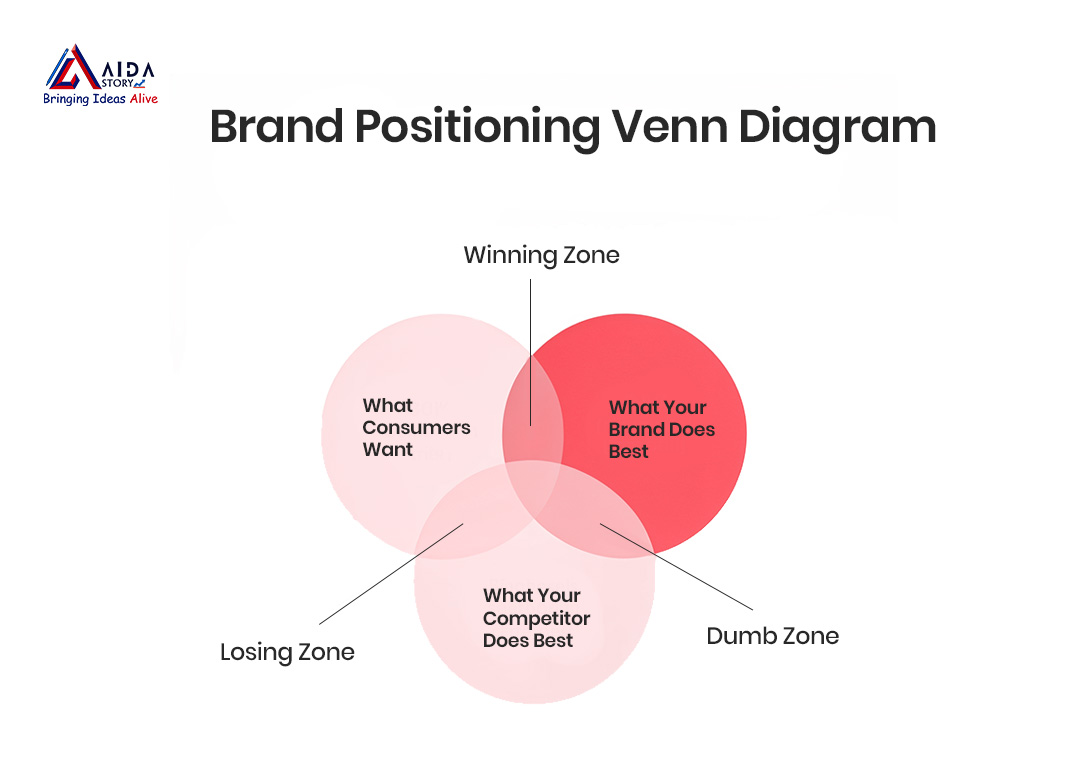In the more litigious and increasingly consumer-sophisticated environment of targeted product sales, businesses are caught between getting the consumer’s attention, developing credibility, and winning the consumer relationship.
The most successful companies achieve this through branding and positioning, two related concepts that form the basis of the marketing undertaken by those businesses.
Although branding and positioning are sometimes synonyms, each has a specific function in explaining how a firm positions its worth and engages with its viewers.
In this blog, we highlight the aspects of branding and positioning, their relevance, and how to synergize branding and positioning to achieve long-term success.
With an understanding of these concepts, it is possible to create a business with significant power to influence the target audience.
What Is Branding?
Branding comprises all of the activities performed within an organization that contribute to determining its image and customers’ perceptions of the company.
It has to do with logos, colors, and mottos, but even more so with what a business offers to its audiences and what they get each time.
Key Components of Branding:
Visual Identity: Identity Icons, writing style, and colors that make up the brand image.
Brand Voice: The written or spoken manner, vocabulary, and composition of an interaction, formal, casual, or professional.
Core Values and Mission: The principles expanded the aims and the goals to establish the company’s direction.
Customer Experience: Customers’ overall experience with your brand across the social channels and the customer service experience.
Branding is emotional. It is the emotion that comes when a person considers your organization. For instance, while analyzing branding, one finds that Apple’s branding communicates innovation, simplicity, and elegance.
It’s a desire for things that look great and work well, but also a desire for control and motivation.
What Is Positioning?
That, in turn, means that positioning is the art and science of strategy. It establishes why a company should be preferred as an organizational constituency by its competitors and what it expects its customers to see. Positioning answers questions like:
- Why would people choose you over your competitor?
- What should customers do or buy from you and not from your competitors?
- What do you provide to your target market that directly addresses their need?
Key Elements of Positioning:
Target Audience: Your target market’s demographic and psychographic characteristics Are fully known.
Value Proposition: A brief description of the benefits that your business offers as well as unique features.
Competitive Differentiation: Emphasizing some aspects that the contenders lack or can’t provide to customers.
Market Niche: The particular corner or area that you operate within the larger market sphere.
Positioning refers to an important strategy for organizations seeking to create a distinct niche in the customer’s mind.
For instance, Tesla is not merely claiming space as a car maker but as the innovator of environmentally friendly luxury cars of the future.
Check Amazon’s guide to brand positioning to improve its application and acquire more information.
Branding vs. Positioning: What’s the Difference?
While branding and positioning are closely related, they have distinct purposes:
Branding focuses on identity. If you select your brand name aptly, it will reveal your proposition, character, and feelings, which is how you wish to be perceived and felt by your audience.
Positioning focuses on strategy. It defines the position of your business and brand against benchmarks so that clients can compare one company to another.
How They Work Together

The research also reveals that branding and positioning are two related processes that support one another.
A strong brand identity complements your chosen positioning strategy by making your value proposition even more distinctive.
In contrast, strategic positioning guarantees that your brand identity is unique and would chime with your target consumers.
For instance, Airbnb’s branding emphasizes inclusivity, adventure, and belonging, while its positioning is precise: a service where guests can explore travel accommodations with hosts in a particular area.
Together, they form a story that supports Airbnb’s strategy and sets it apart from typical hotel corporations.
Branding And Position as an Imperative to Consider

Brand building and positioning, therefore, should not be a preserve of the big firms alone but is an important investment for any firm. Here’s why:
1. Product differentiation in a highly competitive market
Customer awareness is now higher than ever, and branding and positioning help you differentiate yourself from the rest. While clear branding makes your company recognizable, strong positioning makes you easily memorable for the right reasons.
2. Trust and Credibility
Repeating your branding also helps the business gain credibility to a point where you will be perceived as a professional company. Positioning reemphasizes this because it relates the product offering to the needs of the identified consumer group.
3. Driving Customer Loyalty
One of the main reasons customer loyalty exists is that people are loyal to brands they trust and have a kinship with. Building long-term loyalty is part of the company’s objectives, as a loyal customer will only turn to your brand if you meet the requirements of the promise and dominate the market.
4. Promoting growth as well as flexibility
Branding and positioning are then your guide to new product development, expansion into new markets, and shifts in response to market trends in your business.
5. Commanding a Premium Price
The positive effects of the branding and position that are identified mean that it is easy to defend a premium position, charge a premium price, and earn better gross margins.
Customers feel they receive more value from organizations with effective brand management and well-chosen competitive positions.
Importance of Branding and Positioning
Therefore, it is essential to develop a good plan and undertake research, with a clear objective on the need to create a good branding and positioning process. Follow these steps to get started:
Step 1: Define Your Brand Identity
It is time to define your mission, vision, and core values. These foundational elements should be relatable to the targeted audience and in harmony with your organization’s goals and objectives.
Develop a brand personality: Would you describe your personality as friendly, like this ad for Coca-Cola, or professional, like the Tesla brand?
Step 2: Customers and Consumers
Conduct a study to discover what makes your target market tick, what they like, and what they dislike.
Design the detailed buyer persona using surveys and interviews and gaining analytics in branding and positioning strategies.
Step 3: Industry Analysis
To identify your major competitors and adjust your branding and positioning strategies, try the following: Seek out and find the weaknesses or niches where you can compete.
In this case, do not emulate your competitors; rather, concentrate on your areas of differential advantage.
Step 4: Develop Your Unique Selling Proposition (USP)
Explain how your product or service benefits the general public and surpasses solutions offered by competitors. Your UVP needs to be stated simply and directly and point to what your audience wants.
Step 5: Brand Consistency: The Key to a Good Message
Develop communication to depict your organizational brand strategy and espouse your positioning strategy.
Centralize your messaging and tone of voice to align with all the brand points of contact, including the website, social media, and customer service.
Step 6: Choose Your Political Turf
Understand your target market and target a market segment you can serve best depending on the value you offer.
When establishing positioning, you should be able to test it with your target audience and ensure that what you offer meets their expectations.
Step 7: Monitor and Adjust
Branding and positioning are continuous processes. To stay updated, it’s always important to assess promotional tactics, listen to customers, and make necessary adjustments.
To learn how to incorporate branding and positioning effectively, turn to this Forbes article.
The Emotive Dimension of Branding and Positioning
Emotion governs man’s decision-making process. Successful brands and positioning strategies build upon these feelings to establish better relationships with the public.
How to Use Emotion in Branding:
Align Values: This will improve customer perceptions that you have a similar attitude to them and that you’re working towards similar objectives.
Tell Stories: Tell people about your brand’s evolution, purpose, and outcomes.
Evoke Feelings: Develop actions to help customers feel inspired, appreciated, or simply understood.
For instance, while Nike’s motto is ‘Just Do It,’ it is not about selling shoes but about motivating or calling to a higher level of performance.
Likewise, Coca-Cola branding makes people happy and united through campaigns promoting shut events.
Studies of Successful Branding and Company Positioning
Tesla
Branding: The three that Tesla uses in its brand are innovation, luxury, and sustainability.
Positioning: This has established itself as the leading global manufacturer and marketer of luxury EVs for the conscious, wealthy millennial market.
Airbnb
Branding: Airbnb’s branding is all about creating a space that gives everyone a sense of belonging while urging its customers to explore the world.
Positioning: It sets itself apart as a marketplace of authentic local travel experiences through human interaction with hosts.
AIDA Story
Branding: AIDA Story aims to help brands through new approaches to storytelling and inspiring ideas.
Positioning: Still, it is a reliable and preferred collaborator for companies that aim to create powerful brand stories and capture a certain niche. Take a look at what AIDA Story has to offer here.
Most Common Issues Related to Branding and Positioning
1. Inconsistent Branding
Inconsistent visuals, messages, or experiences give the customer the impression that they are confusing and should not be trusted.
2. Weak Positioning
Lack of definition of the competitive edge means the customer himself is not quite certain why he or she should choose your company.
3. Neglecting Market Trends
Consumer behavior or industry dynamics change over time, and thus, your branding and positioning may need to change as well.
4. Not considering the Emotional Aspects
What companies fail to understand is that the masses do not have the capacity to analyze features and benefits; hence, they are deprived of an opportunity to create even more lasting relationships with consumers.
How to Overcome These Challenges:
- Periodically check up on your branding and positioning choices.
- Make sure to know how the market is going and adjust accordingly.
- Emphasize the way you make your audience feel, as this counts for a lot in social media marketing strategies par excellence.
Conclusion
Services marketing: Branding and positioning are not mere marketing functions but the foundation of any business. Together, they identify who you are, what you do, and why customers should address you.
There is substantial potential for many businesses to distinguish themselves along several dimensions and to create genuine value in the eyes of the consumer.
Branding and positioning are continuous business activities, so regardless of whether you are in the early stage of this process or you want to fine-tune your efforts, branding and positioning are constant efforts that need dedication, inspiration, and flexibility.
To learn more about how to create the right brand narrative and reach success in the targeted industry, come to AIDA Story and let your brand stand out.
FAQs
1.Can you tell me the major distinction between branding and positioning?
While branding involves forming an image, positioning, on the other hand, involves creating a niche.
2. What part can branding and positioning play for the small business?
Yes! This recent trend can easily assist small business organizations in creating a differentiated image that will consistently appeal to the right customers, creating a niche and effective competition.
3. When exactly should I be reviewing my branding and positioning?
Look at them at least once yearly or any time you notice a large shift in your market, target audience, or business objectives.
4. Is it possible to save on branding and positioning, and who needs Hays experts?
Although it is not necessary to work with experts, it will be preferable to get professional advice and guarantee the employment of the best practices.
5. What metrics can I use to track the effectiveness of my branding and positioning?
They need to measure brand characteristics such as awareness, perceived customer satisfaction, engagement, and the trend in market share.



